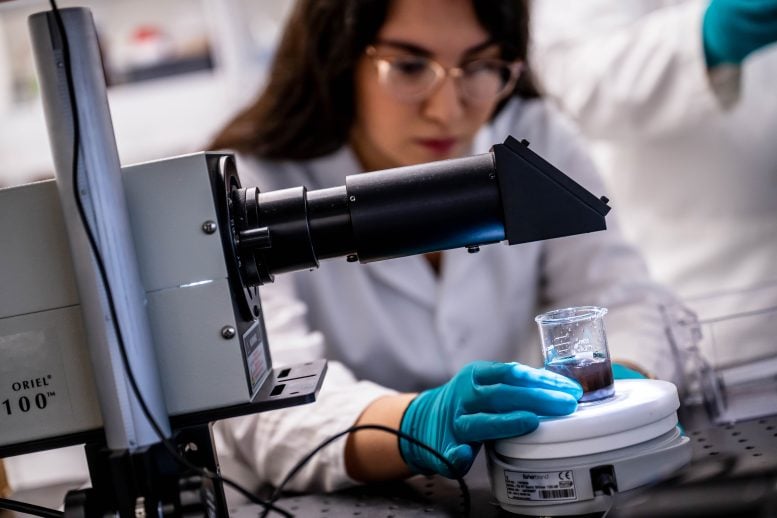Chemical engineers at the University of British Columbia have created a new system that both captures and treats PFAS substances—commonly referred to as "forever chemicals"—in a unified process.
Per- and polyfluoroalkyl substances (PFAS) are widely used in manufacturing consumer goods like waterproof clothing due to their resistance to heat, water, and stains. However, they are also pollutants, often ending up in surface and groundwater worldwide, where they have been linked to cancer, liver damage, and other health issues.
"PFAS are notoriously difficult to break down, whether they're in the environment or in the human body," explained lead researcher Dr. Johan Foster, an associate professor of chemical and biological engineering in the faculty of applied science. "Our system will make it possible to remove and destroy these substances in the water supply before they can harm our health."
Catch and destroy
The UBC system combines an activated carbon filter with a special, patented catalyst that traps harmful chemicals and breaks them down into harmless components on the filter material. Scientists refer to this trapping of chemical components as adsorption.

"The whole process is fairly quick, depending on how much water you're treating," said Dr. Foster. "We can put huge volumes of water through this catalyst, and it will adsorb the PFAS and destroy it in a quick two-step process. Many existing solutions can only adsorb while others are designed to destroy the chemicals. Our catalyst system can do both, making it a long-term solution to the PFAS problem instead of just kicking the can down the road."
No light? No problem
Like other water treatments, the UBC system requires ultraviolet light to work, but it does not need as much UV light as other methods.
During testing, the UBC catalyst consistently removed more than 85 percent of PFOA (perfluorooctanoic acid, a type of forever chemical) even under low light conditions.
"Our catalyst is not limited by ideal conditions. Its effectiveness under varying UV light intensities ensures its applicability in diverse settings, including regions with limited sunlight exposure," said Dr. Raphaell Moreira, a professor at Universität Bremen who conducted the research while working at UBC.
For example, a northern municipality that gets little sun could still benefit from this type of PFAS solution.
"While the initial experiments focused on PFAS compounds, the catalyst's versatility suggests its potential for removing other types of persistent contaminants, offering a promising solution to the pressing issues of water pollution," explained Dr. Moreira.
From municipal water to industry cleanups
The team believes the catalyst could be a low-cost, effective solution for municipal water systems as well as specialized industrial projects like waste stream cleanup.
They have set up a company, ReAct Materials, to explore commercial options for their technology.
"Our catalyst can eliminate up to 90 percent of forever chemicals in water in as little as three hours—significantly faster than comparable solutions on the market. And because it can be produced from forest or farm waste, it's more economical and sustainable compared to the more complex and costly methods currently in use," said Dr. Foster.
Reference: "Hybrid graphenic and iron oxide photocatalysts for the decomposition of synthetic chemicals" by Raphaell Moreira, Ehsan B. Esfahani, Fatemeh A. Zeidabadi, Pani Rostami, Martin Thuo, Madjid Mohseni and Earl J. Foster, 21 August 2024, Communications Engineering.
DOI: 10.1038/s44172-024-00267-4
The research was supported by an NSERC Discovery grant.
News
Gold Nanoclusters Could Supercharge Quantum Computers
Researchers found that gold “super atoms” can behave like the atoms in top-tier quantum systems—only far easier to scale. These tiny clusters can be customized at the molecular level, offering a powerful, tunable foundation [...]
A single shot of HPV vaccine may be enough to fight cervical cancer, study finds
WASHINGTON -- A single HPV vaccination appears just as effective as two doses at preventing the viral infection that causes cervical cancer, researchers reported Wednesday. HPV, or human papillomavirus, is very common and spread [...]
New technique overcomes technological barrier in 3D brain imaging
Scientists at the Swiss Light Source SLS have succeeded in mapping a piece of brain tissue in 3D at unprecedented resolution using X-rays, non-destructively. The breakthrough overcomes a long-standing technological barrier that had limited [...]
Scientists Uncover Hidden Blood Pattern in Long COVID
Researchers found persistent microclot and NET structures in Long COVID blood that may explain long-lasting symptoms. Researchers examining Long COVID have identified a structural connection between circulating microclots and neutrophil extracellular traps (NETs). The [...]
This Cellular Trick Helps Cancer Spread, but Could Also Stop It
Groups of normal cbiells can sense far into their surroundings, helping explain cancer cell migration. Understanding this ability could lead to new ways to limit tumor spread. The tale of the princess and the [...]
New mRNA therapy targets drug-resistant pneumonia
Bacteria that multiply on surfaces are a major headache in health care when they gain a foothold on, for example, implants or in catheters. Researchers at Chalmers University of Technology in Sweden have found [...]
Current Heart Health Guidelines Are Failing To Catch a Deadly Genetic Killer
New research reveals that standard screening misses most people with a common inherited cholesterol disorder. A Mayo Clinic study reports that current genetic screening guidelines overlook most people who have familial hypercholesterolemia, an inherited disorder that [...]
Scientists Identify the Evolutionary “Purpose” of Consciousness
Summary: Researchers at Ruhr University Bochum explore why consciousness evolved and why different species developed it in distinct ways. By comparing humans with birds, they show that complex awareness may arise through different neural architectures yet [...]
Novel mRNA therapy curbs antibiotic-resistant infections in preclinical lung models
Researchers at the Icahn School of Medicine at Mount Sinai and collaborators have reported early success with a novel mRNA-based therapy designed to combat antibiotic-resistant bacteria. The findings, published in Nature Biotechnology, show that in [...]
New skin-permeable polymer delivers insulin without needles
A breakthrough zwitterionic polymer slips through the skin’s toughest barriers, carrying insulin deep into tissue and normalizing blood sugar, offering patients a painless alternative to daily injections. A recent study published in the journal Nature examines [...]
Multifunctional Nanogels: A Breakthrough in Antibacterial Strategies
Antibiotic resistance is a growing concern - from human health to crop survival. A new study successfully uses nanogels to target and almost entirely inhibit the bacteria P. Aeruginosa. Recently published in Angewandte Chemie, the study [...]
Nanoflowers rejuvenate old and damaged human cells by replacing their mitochondria
Biomedical researchers at Texas A&M University may have discovered a way to stop or even reverse the decline of cellular energy production—a finding that could have revolutionary effects across medicine. Dr. Akhilesh K. Gaharwar [...]
The Stunning New Push to Protect the Invisible 99% of Life
Scientists worldwide have joined forces to build the first-ever roadmap for conserving Earth’s vast invisible majority—microbes. Their new IUCN Specialist Group reframes conservation by elevating microbial life to the same urgency as plants and [...]
Scientists Find a Way to Help the Brain Clear Alzheimer’s Plaques Naturally
Scientists have discovered that the brain may have a built-in way to fight Alzheimer’s. By activating a protein called Sox9, researchers were able to switch on star-shaped brain cells known as astrocytes and turn them into [...]
Vision can be rebooted in adults with amblyopia, study suggests
Temporarily anesthetizing the retina briefly reverts the activity of the visual system to that observed in early development and enables growth of responses to the amblyopic eye, new research shows. In the common vision [...]
Ultrasound-activated Nanoparticles Kill Liver Cancer and Activate Immune System
A new ultrasound-guided nanotherapy wipes out liver tumors while training the immune system to keep them from coming back. The study, published in Nano Today, introduces a biodegradable nanoparticle system that combines sonodynamic therapy and cell [...]





















